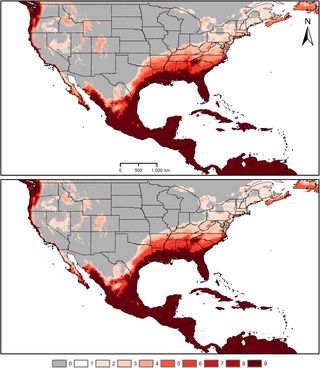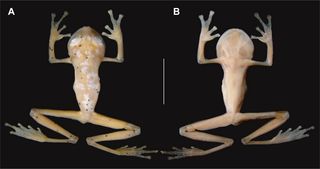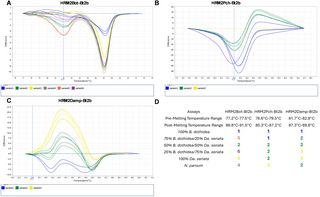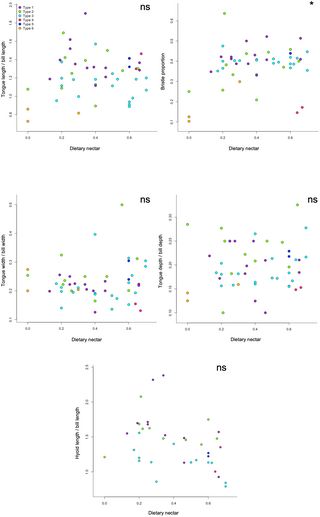Suffolk leading the way with the earliest evidence of fire lighting.
10.12.2025 18:54 — 👍 2 🔁 0 💬 1 📌 0

Forage preference in two geographically co-occurring fungus gardening ants: A dietary DNA approach
Traditional methods of forage identification are impractical with non-leafcutting fungus gardening ants, making diet-related ecological and life history questions difficult to study. To address this…
A study by @antsymbiosis.bsky.social and colleagues uses DNA metabarcoding to study how plant foraging differs between co-occurring fungus-gardening ant species. Diet preference appears driven both by species-specific plant preference, and location-specific resource availability.
plos.io/4pY5qLh
10.12.2025 14:02 — 👍 1 🔁 2 💬 0 📌 0

Postcranial anatomy of the Late Miocene Eurasian hornless rhinocerotid Chilotherium
The hornless rhinocerotid genus Chilotherium is one of the most common rhinoceroses found in Eurasia during the Late Miocene, even being the most abundant large mammal in some localities. Despite its…
A new study from Panagiotis Kampouridis and colleagues describes postcranial material from three Late Miocene Eurasian hornless rhinocerotid Chilotherium species, and identifies characters useful for species identification and phylogenetic inference.
09.12.2025 10:30 — 👍 2 🔁 3 💬 0 📌 0

Potential distribution of Aedes vittatus as an invasive species in North America
The recent detection of populations of the mosquito Aedes vittatus in the Dominican Republic and Cuba has raised concerns over its potential for broader invasion in the Western Hemisphere, and…
Aedes vittatus, native to Africa and Asia, is a significant vector of yellow fever, Zika, chikungunya and dengue. Modelling from @atpbiodiv.bsky.social and colleagues highlights year-round suitable areas for Aedes vittatus in USA, Mexico, Central America and Caribbean islands.
08.12.2025 19:00 — 👍 3 🔁 5 💬 0 📌 0

Unraveling the herpetofauna diversity in canga and forest ecosystems of the Eastern Amazon
Species inventories are essential for discovering new taxa, improving knowledge of species’ geographic distributions, characterizing local richness, evaluating biodiversity loss, and contributing to…
A new study from Ana Lúcia Costa Prudente et al surveys amphibians and reptiles from canga (‘ironstone savanna’) and forest habitats in southeastern Pará, Brazil, and provides a DNA‑barcode library of 860 COI and 16S rRNA sequences to support future biodiversity research.
02.12.2025 14:01 — 👍 2 🔁 2 💬 0 📌 0

eDNA reveals spatial differences in species composition of protected rockfishes
Rare species are difficult and time-consuming to detect, but environmental DNA (eDNA) methods can be used to increase data availability for monitoring and management. Here, we use the diverse…
A new study from @stephaniematthews.bsky.social and colleagues uses eDNA metabarcoding to show spatial differences in protected rockfish species composition, supporting eDNA as a tool for detecting rare and difficult to observe species in the marine environment:
02.12.2025 17:30 — 👍 3 🔁 2 💬 0 📌 0

High-Resolution Melting assays development for discrimination of fungal pathogens causing Grapevine Trunk Diseases
Grapevine Trunk Diseases are a set of fungal diseases that mainly affect wood tissues of grapevine, reducing plant fitness and yield. These diseases limit grape production, so producers need to…
Grapevine Trunk Diseases cause significant losses to grape producers. A new study by Azevedo-Nogueira and colleagues develops High-Resolution Melting assays that discriminate fungal pathogens causing these diseases, enabling rapid species-level detection and informed management:
03.12.2025 12:30 — 👍 1 🔁 2 💬 0 📌 0

We have just 7 days to raise £15,000 for nature’s recovery in Suffolk!
Until 9 December any donation made via the Big Give website will be doubled. This means if you donate £25, we’d receive £50, and your support has double the impact.
🔗 https://donate.biggive.org/campaign/a05WS000005AY5ZYAW
02.12.2025 10:15 — 👍 1 🔁 1 💬 0 📌 0

More than 16,000 tracks found at a ‘dinosaur freeway’ in Bolivia | CNN
Theropods once trekked along a “dinosaur freeway” that stretched across a shoreline in what is now Bolivia, according to a new study.
Esperante et al report 1321 theropod trackways, 16,600 exposed dinosaur tracks, plus numerous solitary tracks, abundant tail traces and swim tracks at Carreras Pampa tracksite in Torotoro National Park, Bolivia.
edition.cnn.com/2025/12/04/s...
Original article: journals.plos.org/plosone/arti...
05.12.2025 11:36 — 👍 3 🔁 3 💬 0 📌 0

Image shows a large white bird with a long, curved beak and red face (a crested ibis) standing in an area of vegetation. Image credit: Siqi Wang, Yangxian County, Shaanxi, China. CC-BY 4.0
Is all wildlife #conservation good? In this Perspective, Tien Ming Lee &co discuss whether it is possible to over-conserve charismatic species and call for greater focus on whole ecosystems in conservation measures of success.
#wildlife #WorldWildlifeConservationDay 🧪
plos.io/4nQ0Ygo
04.12.2025 17:45 — 👍 9 🔁 3 💬 0 📌 0

New on the blog! In an interview with Veronique Kiermer @verokiermer.bsky.social, Chief Scientific Officer for @plos.org, she provides insight into their approach to data sharing, visibility and evaluation.
👉 Read the post: makedatacount.org/read-our-blo...
#dataevaluation #datasharing
02.12.2025 16:03 — 👍 5 🔁 5 💬 0 📌 1

The phenotypic spaces of Arabidopsis thaliana F2s vs. wild accessions. The results shown correspond to one of the 10 hypervolume calculations. Left: Trait hypervolumes based on the first three principal component analysis (PCA) dimensions (with opaque dots representing observed data points, and semitransparent small dots representing uniformly distributed random points generated by the algorithm used for hypervolume computation). Hypervolumes with size equivalent to the mean of the 100 hypervolumes generated by resampling per group (F2s vs. accessions) are shown. Right: Trait variation within the phenotypic spaces of A. thaliana F2s (blue) and wild accessions (red) considering the first three PCA dimensions of trait hypervolumes. Hypervolume centroids, observed data points, and uniformly distributed random points generated by the algorithm used for hypervolume computation are depicted by large circles, opaque dots, and semitransparent small dots, respectively. Hypervolumes with size equivalent to the mean of the 100 hypervolumes generated by resampling per group (F2s vs. accessions) are shown. LA, leaf area; LDMC, leaf dry matter content; LNC, leaf nitrogen content; SLA, specific leaf area.
Why do we observe some plant #phenotypes but not others? This study explores the multivariate #PhenotypicSpace of a widely distributed #plant species to reveal how interplays between population history & natural selection shape phenotypic diversity in #Arabidopsis @plosbiology.org 🧪 plos.io/43Z8IWi
02.12.2025 13:55 — 👍 4 🔁 2 💬 0 📌 0
White supremacy and misogyny, particularly "the double bind" of racism and misogyny, confounds meritocracy in academia
02.12.2025 15:11 — 👍 24 🔁 16 💬 1 📌 0

The Ten Best Science Books of 2025
From “experimental archaeology” to the mysterious appeal of exploration, the wide-ranging subjects detailed in these titles captivated Smithsonian magazine’s science contributors this year
Once more, @smithsonianmag.bsky.social asked me for my favorite science books out this year. I picked Mary Roach's Replaceable You and Sadiah Qureshi's Vanished, the latter of which I especially recommend for the way it offers an important new view of what we mean when we talk about extinction.
02.12.2025 15:15 — 👍 21 🔁 8 💬 1 📌 0

Suffolk Wildlife Trust completes purchase of Worlingham Marshes
Suffolk Wildlife Trust says it is really thankful to everyone who donated to its appeal.
Two recent wins for nature in Suffolk:
@suffolkwildlife.bsky.social purchases Worlingham Marshes, a step towards a River Waveney wildlife corridor: www.bbc.co.uk/news/article...
Mid Suffolk District Council (led by @midsuffolkgreen.bsky.social) pledges £1.8m for nature: www.bbc.co.uk/news/article...
02.12.2025 12:04 — 👍 1 🔁 0 💬 0 📌 0

World AIDS Day 2025 - "Overcoming disruption, transforming the AIDS response" - EveryONE
An interview with PLOS One Section Editor Professor Limin Mao discussing how HIV/AIDS research the field has developed during the last two years…
On #WorldAIDSDay, Section Editor Limin Mao discusses HIV research and society.
'HIV research has always been about people: their courage, creativity and determination to care for one another. HIV is not only a disease but also magnifies socioeconomic disparities.'
everyone.plos.org/2025/12/01/w...
01.12.2025 13:11 — 👍 3 🔁 4 💬 0 📌 0
Did any #plantscience colleagues attend the #canvas25 meeting held by the tri-societies @asa-cssa-sssa.bsky.social? PLOS One's @patrickgoymer.bsky.social shares his experience on our blog. cc @globalplantgpc.bsky.social #plantsci 🌿🧪🔬🌱
25.11.2025 16:39 — 👍 5 🔁 4 💬 1 📌 0

Impressions of a broad CANVAS - EveryONE
Posted on behalf of PLOS One’s Life Sciences Division Editor Patrick Goymer The American Society of Agronomy (ASA), Crop Science Society of…
Our Life Science Division Editor @patrickgoymer.bsky.social recently attended @asa-cssa-sssa.bsky.social's #CANVAS25 meeting in Salt Lake City, and reports back here on the journal's EveryOne blog:
everyone.plos.org/2025/11/25/i...
25.11.2025 13:45 — 👍 1 🔁 2 💬 0 📌 1

Sleep pressure and slow-wave-rich NREM sleep exert distinct effects on cerebral vasomotion and on brain pulsations driven by respiratory and cardiac forces. Heightened sleep pressure (following 35 h of wakefulness) promotes vasomotion (yellow box). Slow-wave-rich NREM sleep enhances brain pulsations driven by the respiratory and cardiac cycles—more so in gray and white matter than in the ventricles (red boxes). The respiration- and cardiac-driven brain pulsations also intensify with deeper sleep (N3 > N2) and correlate with EEG delta power, which is a measure of slow-wave activity (light vs. dark red boxes).
Sleep supports brain health partly by regulating fluid dynamics to clear waste. @ulvlarsen.bsky.social &co probe the relation between #sleep & fluid movement in the human #brain, finding that #SleepPressure & intensity have distinct effects on brain pulsations @plosbiology.org 🧪 plos.io/3XQWCL6
25.11.2025 14:07 — 👍 18 🔁 10 💬 1 📌 0

I was interviewed by Newsweek about the backlash to my DPhil announcement. You can read it here:
www.newsweek.com/gen-z-woman-...
25.11.2025 12:14 — 👍 191 🔁 25 💬 10 📌 1
Theoretical physicist in theoretical biology 🦠
Interested in evolution and adaptation.
Postdoc – MPI for Evolutionary Biology
PhD – University of Leeds
Undergrad – University of Manchester
masker.science
Postdoc at the Department of Natural History, @universitetsmuseet.bsky.social, @unibergen.bsky.social | Interested in diversity, ecology and life cycles of Cnidaria and Ctenophora 🪼🪸|
The Michael Sars Centre, University of Bergen, is an international community of scientists studying the molecular and cellular biology of marine organisms.
https://linktr.ee/michaelsarscentre
Studying cells inside embryos since way before it was cool.
https://www.wallingfordlab.org/
We mobilise the humanities and social sciences to understand the world and shape a brighter future.
Stop-and-chat avoider. Lido afficionado. Was once world's youngest person, albeit briefly.
Anthropologist interested in hunter-gatherer egalitarianism | Asst Prof @BaylorAnthro.bsky.social | Editor-in-Chief, Hunter-Gatherer Research | Spelling errors my own
Traces & trace fossils. Wrote 'Life Sculpted' (2023), 'Dinosaurs Without Bones' (2014), 'The Evolution Underground' (2017), & more. Hubby, Trekkie, reading, cooking, craft-beer imbibing, childless cat dude, 🚫AI. 🧪🐾🦖🦕🪨⚒️🌍📚✍️ 🖖 https://ajmartinauthor.com
Evolutionary biologist studying sexual selection, mating behavior, and rapid evolution | PhD student in the Tinghitella lab at the University of Denver
Postdoc at UC Davis • Evolutionary biologist and behavioral ecologist 🦗🐟
I study the processes that generate phenotypic variation, from individuals to populations.
Composer • Cellist • Game designer • Tennis player
jameshgallagher.weebly.com
Immunologist and Drosophila gut aficionado
Ecologist, author, tree watcher. Shill for Big Forest. Writing another textbook on biodiversity and biogeography. It's always karaoke time. More at treesinspace.com
We explore the dark side of biodiversity. Soils | Biodiversity-ecosystem functioning | Experiments | Global analyses | From the Petri dish to the field
One of the longest-running grassland biodiversity experiments worldwide (since 2002).
Uncovering the mechanisms that drive biodiversity-ecosystem functioning (BEF) relationships over time.
https://the-jena-experiment.de
Funding: @dfgpublic.bsky.social
Adj Professor at University of Fiji - IPCC AR7 Coordinating Lead Author - Decolonizing Science - Climate Justice - Adaptation & Resilience building - Climate Impacts Scientist - Small Islands - Biodiversity Hotspots - Trying to fill the data gaps
🌱 science section editor @carbonbrief.org 🌱
One of the leading peer-reviewed journals in ecology, owned by the @nordicoikos.bsky.social. Publishes research papers where different aspects of ecology are brought together.
A global, inclusive community of researchers who believe rigorous research deserves to be discoverable, widely disseminated and freely accessible, working to advance science for the benefit of all.
Professor of Microbiome Ecology at Institute of Biology, Leiden University
Bacillus subtilis, biofilms, plant microbiome, bacteria-fungi interactions and circadian clock within @microclockerc.bsky.social #ERCSyG
https://linktr.ee/atkovacs
Official feed for Smithsonian magazine. @ replies may be reprinted in the magazine. Legal: http://si.edu/Termsofuse


























